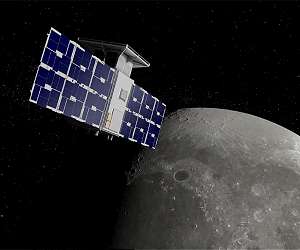NASA and several other national space agencies have recently revived their lunar colonization programs. One of the key factors that needs to be solved is how to power a future such colony. Can uninterrupted solar power feasibly be realized without energy storage? On Earth, providing 100% of electricity demand 100% of the time solely from renewables, but without energy storage, is unfeasible.
This earth-bound mindset has been challenged recently by a paradigm shift developed by Ben-Gurion University’s Prof. Jeffrey Gordon, which he was invited to present to NASA in late August.
On the Moon, solar is the sole available renewable resource. The overriding challenge is to completely supply the main energy consumer: factories that need to continuously (24/7, 365 days a year) produce thousands of tons of oxygen (O2) per year from the lunar soil, for rocket propellant, orbiting satellite refueling and human sustenance. A large part of the challenge derives from any location on the Moon on average spending half of the lunar rotational period of 29.5 days in the dark.
In his paper, Gordon documents a feasible strategy where uninterrupted electricity would be produced by photovoltaic (PV) arrays installed around a 360 latitudinal ring close to (but not at) a lunar pole, with transmission lines installed to the O2 plants for which there would then be substantial remote siting flexibility.
“My solution has a specific mass far below all alternatives so far, namely, record low kg/kW, a key figure of merit for affordable and feasible lunar installations, with launch and installation costs currently exceeding $1,000,000/kg. Our new strategy is more than a factor of 100 better than solar with battery storage. It is also at least a factor of 6 superior to the solution now being contemplated by NASA of nuclear reactors driving conventional turbines and generators.”
“I was invited to present my findings at NASA’s headquarters for solar power in space in August at the Glenn Research Center in Cleveland, Ohio. NASA scientists expressed a preparedness to rethink the plan to power lunar colonies with nuclear energy instead of solar energy,” says Gordon.
The concept exploits the unique combination of (a) the absence of a lunar atmosphere, (b) the near-zero tilt of the Moon’s polar axis with respect to the ecliptic plane, (c) lunar conditions being amenable to low-mass inexpensive transmission lines, and (d) a lunar diameter far smaller than that of Earth.
Prof. Gordon is a member of the Department of Solar Energy and Environmental Physics, Jacob Blaustein Institutes for Desert Research of Ben-Gurion University.
Research Report:Uninterrupted photovoltaic power for lunar colonization without the need for storage
Related Links
Ben-Gurion University of the Negev
Mars News and Information at MarsDaily.com
Lunar Dreams and more
|
We need your help. The SpaceDaily news network continues to grow but revenues have never been harder to maintain. With the rise of Ad Blockers, and Facebook – our traditional revenue sources via quality network advertising continues to decline. And unlike so many other news sites, we don’t have a paywall – with those annoying usernames and passwords. Our news coverage takes time and effort to publish 365 days a year. If you find our news sites informative and useful then please consider becoming a regular supporter or for now make a one off contribution. |
||
|
SpaceDaily Contributor $5 Billed Once credit card or paypal |
SpaceDaily Monthly Supporter $5 Billed Monthly paypal only |
|

![]()
CAPSTONE completes successful maneuver, teeing up Lunar orbit
Washington DC (SPX) Nov 01, 2022
The CAPSTONE spacecraft successfully completed a trajectory correction maneuver on Thursday, Oct. 27, teeing up the spacecraft’s arrival to lunar orbit on Nov. 13.
CAPSTONE is no longer in safe mode following an issue in early September that caused the spacecraft to spin. The team identified the most likely cause as a valve-related issue in one of the spacecraft’s eight thrusters.
The mission team will design future maneuvers to work around the affected valve, including the two remaining tra … read more
